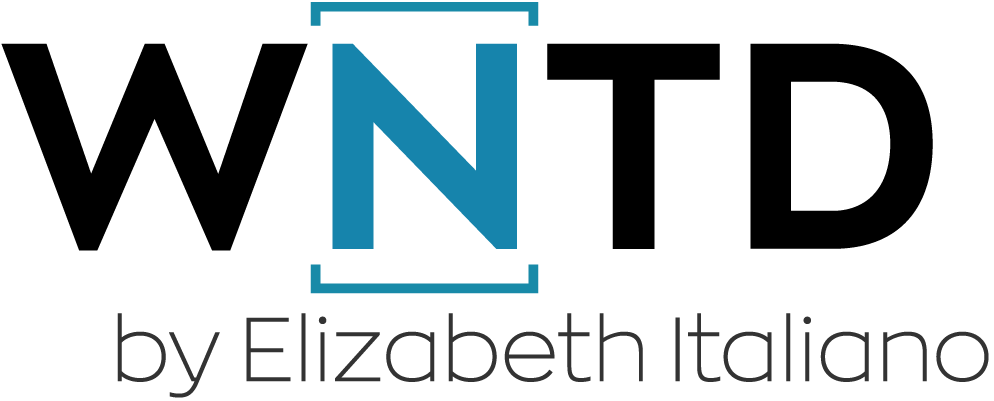We are in the midst of a generational change. You may immediately think that I am referring to AI but there’s another key shift occurring.
We are witnessing a substantial shift in the demographics and preferences of our buyers. Today, 71% of business buyers are under the age of 45, and a staggering 86% of these buyers express dissatisfaction with the buying process. Additionally, 66% of buyers find that sellers are unhelpful. These changes have resulted in seller attainment reaching an all-time low.
While many are attributing these sales attainment challenges solely to economic conditions, the truth is that our approach to selling plays a significant role in our performance. For years we have forced buyers into a seller centric sales model that have favored MEDDIC interrogation style discovery, hiding pricing and a frustrating buyer experience, over a buyer-centric approach that helps guide buyers through their decision making process.
In the realm of renewals, renewing solutions that were once considered nice-to-haves is no longer a simple task. To win renewals, we must prove that our solutions are essential, solving top-priority problems and driving results aligned with key business goals. These difficulties with renewals make expansion sales even more challenging. After all, if we risk losing a customer entirely, how can we expect to expand their engagement with us?
The Need for a Buyer-Led Approach in Modern Sales
Whether selling to new prospects or existing clients, today’s business buyers have high expectations. According to Salesforce, 84% of business buyers believe that sales reps should act as trusted advisors, yet 73% report that most sales interactions feel transactional. What we mean by ‘trusted advisors’ is being seen by buyers and customers as a trusted resource who facilitates their purchase evaluation and decision-making, enabling them to achieve their business goals through the ongoing use of the solution in question.
This stark disconnect highlights a fundamental issue: the entire end-to-end go-to-market and revenue motion is broken. The market has changed, and we must adapt to thrive, not just survive.
To help facilitate a meaningful, structured and planned approach to selling, there are many frameworks, methodologies, and approaches on the market today, such as MEDDIC, MEDDPICC, and SPIN. While the methodology one chooses is really a matter of preference, what we are seeing in the field these days is that most of them are overly complex and theoretical, somewhat confusing, and in the end more inwardly focused (more aligned to seller’s internal processes vs. buyer’s or customer’s actual buying journey). In the end, the core elements that we need to address are: the Problem clients are trying to solve, the Action that needs to be taken to solve those problems, the Results that the client needs to achieve, and the Trigger that is making this an important enough problem to solve right now. This is why we have put in the work, both with ourselves and our clients, to adapt and create the PART framework, which is a full revenue cycle buyer and customer enablement framework.
PART stands for Problem, Action, Result, and Trigger, and it’s designed to keep us laser-focused on solving our buyers’ and customers’ most pressing problems. By zeroing in on their most pressing and high-priority Problems, PART makes sellers and CSMs indispensable, boosting our success in closing deals and maintaining loyal customers.
Introducing PART: A Buyer and Customer Enablement Framework
Here is a breakdown of PART for new business and existing customers.
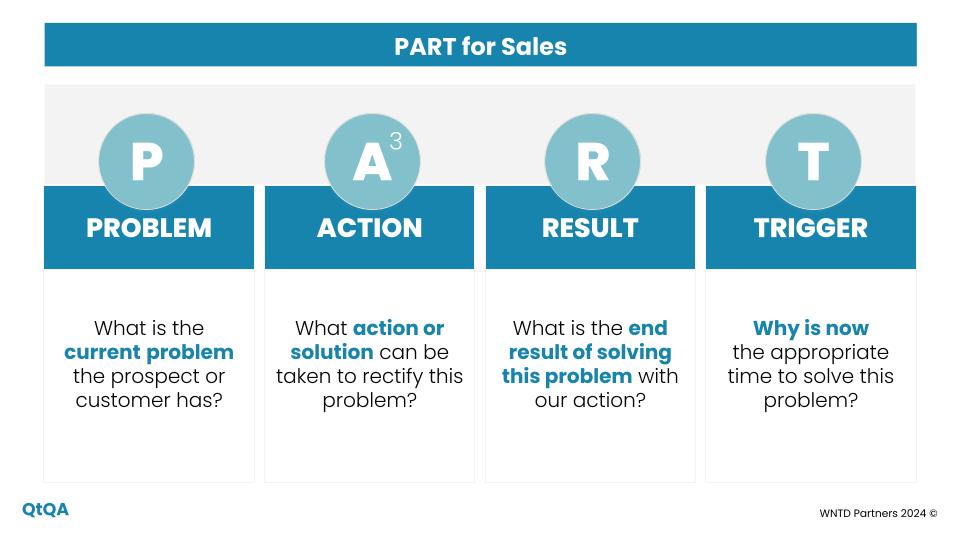
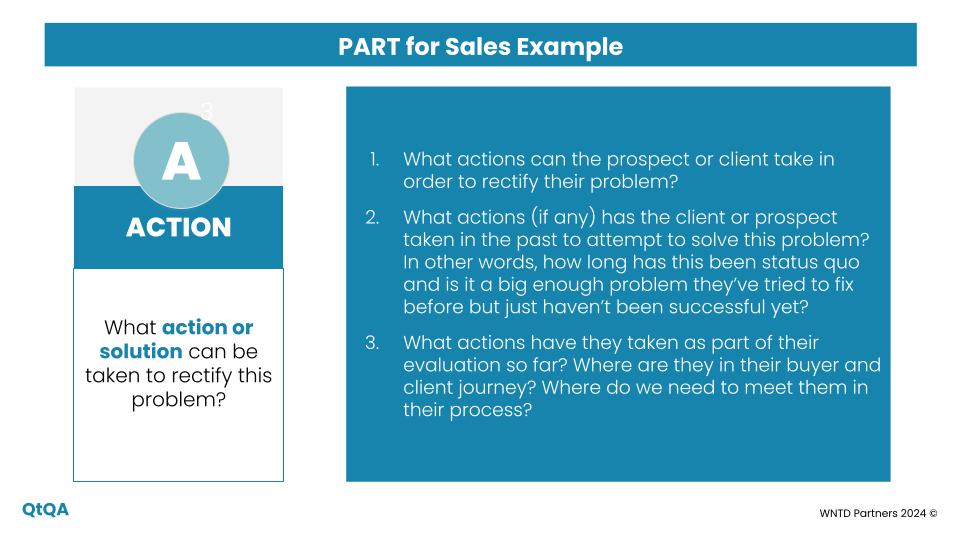
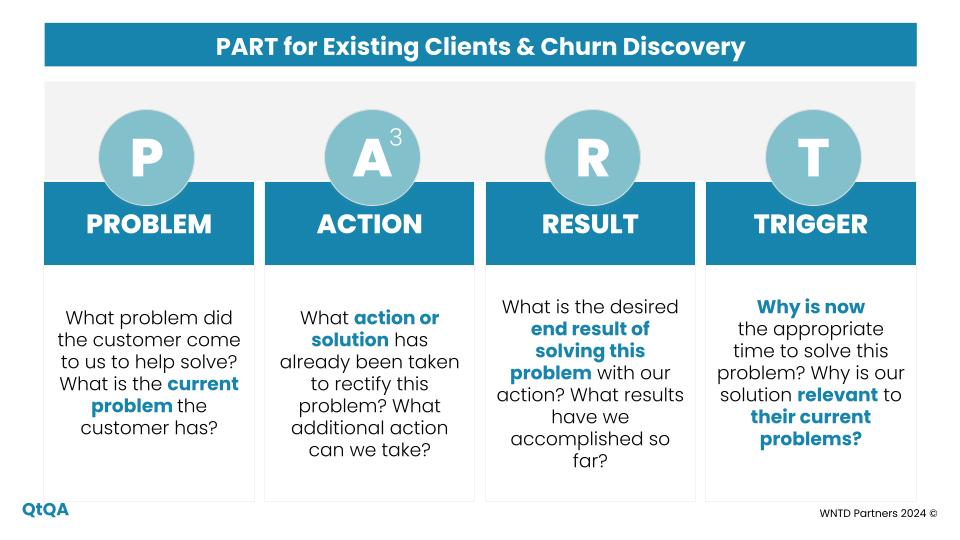
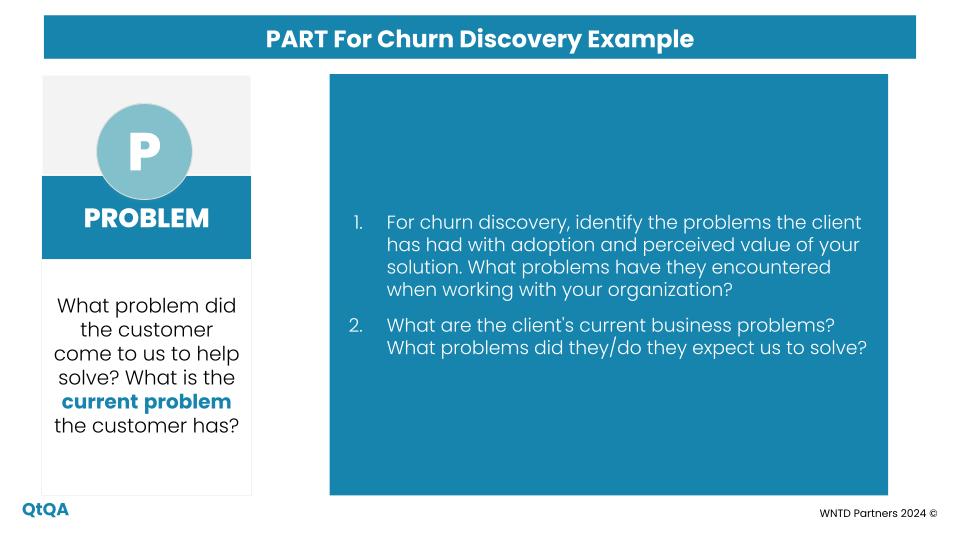
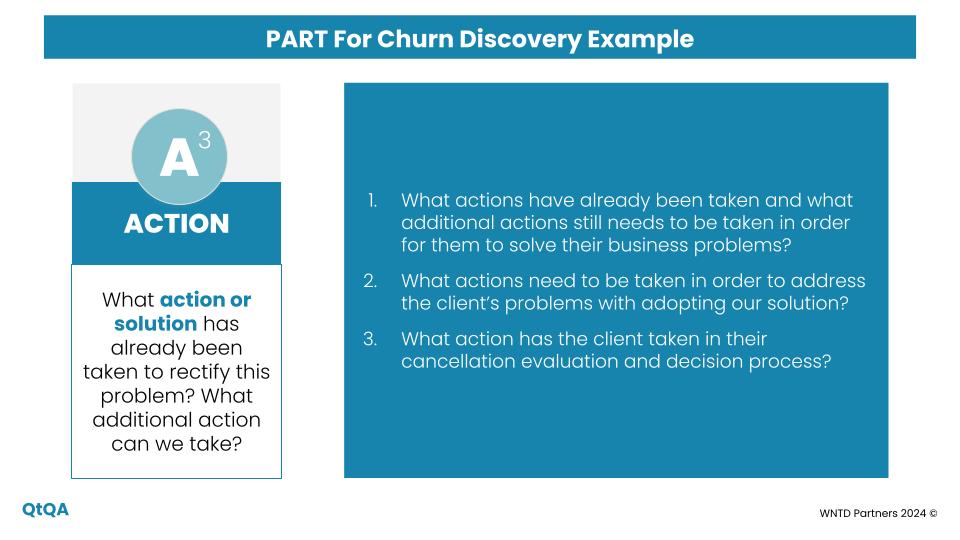
PART has been created to enable the entire end-to-end revenue generation cycle, from prospecting, to qualification, opportunity management, the sales to CS handoff, onboarding, adoption, renewal and expansion.
It helps formulate a hypothesis and problem statements during research, enabling sellers to create genuinely personalized messaging as opposed to fake personalization. When qualifying opportunities, it allows sellers to assess not only the fit of the prospect or client but also the viability of the deal.
From a customer success perspective, PART enables Customer Success Managers (CSMs) to anchor their strategy and actions to the most pressing problems and business goals their clients are looking to address. By putting buyers’ and clients’ problems and goals front and center, PART ensures that reps meet them where they are in their journey. It also allows reps to align with clients in a way that ensures their solution stays relevant to the client’s evolving needs, problems and goals.
So let’s dive more into each component of PART, starting with Problem.
P: Problem
The first component of PART is the Problem. This is the anchor point for everything. What is the current problem the prospect or customer has?
There are two layers to this: a rational/business-centric problem and an emotional problem tied to a specific person or team. In the past, addressing emotional problems like saving someone time or reducing team bandwidth might have been enough. However, in today’s world, identifying a strong rational problem is equally important because buyers and clients require a robust business case to justify their spending.
So, why is this, what changed? In the COVID and immediate post-COVID eras, money was cheap, so the risk of spending was low. However, when the economy took a hit, money became more expensive and spending became highly scrutinized. Every dollar spent had to be justified. While buyers may still make initial decisions or judgements with emotion they now have to clearly back any spending decision up with a clear and rational business case.
For example, imagine we are a rep at a company called RevIntel Co, selling call recording and revenue intelligence solutions to a company named MarTech Co. A problem MarTech Co has is that they lost ten opportunities that were forecasted as ‘Commit’ last quarter, and have no idea why. The reason why they don’t know the reason for losing them is because of the lack of visibility into prospect calls.
This issue has been recurring, leaving them at 36% of their annual quota. Leadership is facing capacity constraints and low morale due to this. Now, there are numerous problems here and it’s clear that there needs to be some form of root cause diagnosis to get to the bottom of the actual problem, but for the purposes of this example we are going to focus on the tactical problems at hand, i.e. their inability to analyze prospect calls.
Next we get into Action, and we’ll continue with how we apply the Action component of PART to this example.
A: Action
This component adds a multi-dimensional approach to our process, encompassing past actions, potential actions, and evaluation actions.
- Past Actions: What actions has the prospect or client taken in the past to solve this problem? How long has this been the status quo? Is it a significant problem they’ve attempted to fix before but haven’t succeeded? This helps gauge if the problem is important enough to solve and whether the deal has momentum.
- Potential Actions: What actions can the prospect or client take to rectify their problem? This is where our solution might come into play, but it isn’t necessarily specific to us. What actions, in general, would satisfy their problem? Visibility into calls? Proactive deal warnings? More bandwidth for leadership?
- Evaluation Actions: What actions have they taken in their evaluation process so far? Where are they in their buyer and client journey? Have they started speaking to other solutions? Have they initiated proofs of concept? This ensures we align with the buyer’s journey and adjust our pace accordingly.
For example, going back to the MarTech Co’s example, when the issue started two quarters ago, the leadership asked the managers to join prospect calls to ensure everything was in line. However, this approach did not scale, leading to overwhelmed managers and turnover that MarTech Co couldn’t afford. The improvement in opportunities was negligible. Now, they need a scalable way to understand what’s happening in prospect and client calls and they are looking for technology that can capture the true voice of the customer and signal to leadership any signs of a deal going off track. They’ve already started their search, engaging a call recording tool and having intro calls with three other solutions. Knowing this, we can better inform the action we take next, such as conducting discovery with each stakeholder to understand their top decision criteria.
Next we have Result.
R: Result
The Result component asks what the end result of solving the problem with our action is. This cannot be a nebulous outcome like saving time. We need to understand the quantifiable results they need at both a top business level and a stakeholder level, establishing a business case, ROI, and overcoming the cost of inaction.
Continuing with our MarTech Co example, if we provide them with visibility into their opportunities, they can spot deals and renewals at risk and prevent revenue loss. This would certainly help them towards moving from 36% presently to 60% revenue attainment by the end of the quarter, and closer to 100% by the end of the year, which is their required result. For stakeholders, scalable technology would give sales leaders more capacity to focus on coaching, alleviate job security fears, and allow reps to manage more deals, increasing pipeline and win rates.
During evaluation, we must give them confidence in achieving these results, and post-implementation, we need to deliver on this promise. PART helps AEs and CSMs map out their account strategy to align actions with proving and demonstrating results, synchronizing our internal processes with buyer and client needs.
T: Trigger
Finally, the Trigger ties everything together. Why is it important to solve their problem with our actions and achieve this result now? Without a driving factor, it’s just a conversation, not an active opportunity.
For example, through discussions, we identify that attaining profitability and minimizing operating expenses (OpEx) spend is MarTech Co’s #1 priority this year. We know our platform helps improve revenue and minimize OpEx, tying our problem, action, and result to this top priority. Additionally, we determine when they need a solution in place to see benefits before the end of their fiscal year.
Why PART?
The beauty of the PART framework lies in its flexibility. It can be used as a standalone methodology or in conjunction with others like MEDDIC. In our Buyer Enablement & Customer Journey course, we teach how to use PART across sales and customer success to close revenue, including renewals, while enhancing the buyer and customer experience.
We developed PART because sales, renewals, and expansion have often been treated as linear processes, while the reality of decision-making is far more complex. By giving reps a balance of process and the freedom to think critically, we enable them to guide buyers and clients effectively, without forcing them through rigid checklists or CRM stages.
The industry has become obsessed with scaling, often at the expense of quality. PART is easy to remember and implement, helps reps develop critical thinking skills and pattern recognition, supports win/loss analysis, and ultimately teaches reps how to replicate successful strategies in closing deals and renewals.
In our next blog post we will share more about how PART can be applied to existing customers as well.
Conclusion
In our Quest to Quota Attainment course we demonstrate how to apply PART across the full buyer and customer journey.
If you’d like to learn more about PART and our Quest to Quota Attainment, please visit What Not To Do and follow us on LinkedIn. We’ve also posted this video that walks through PART in more detail. By embracing the PART framework, we can navigate the new landscape of sales, renewals, and expansions, ensuring success for ourselves and our clients.
